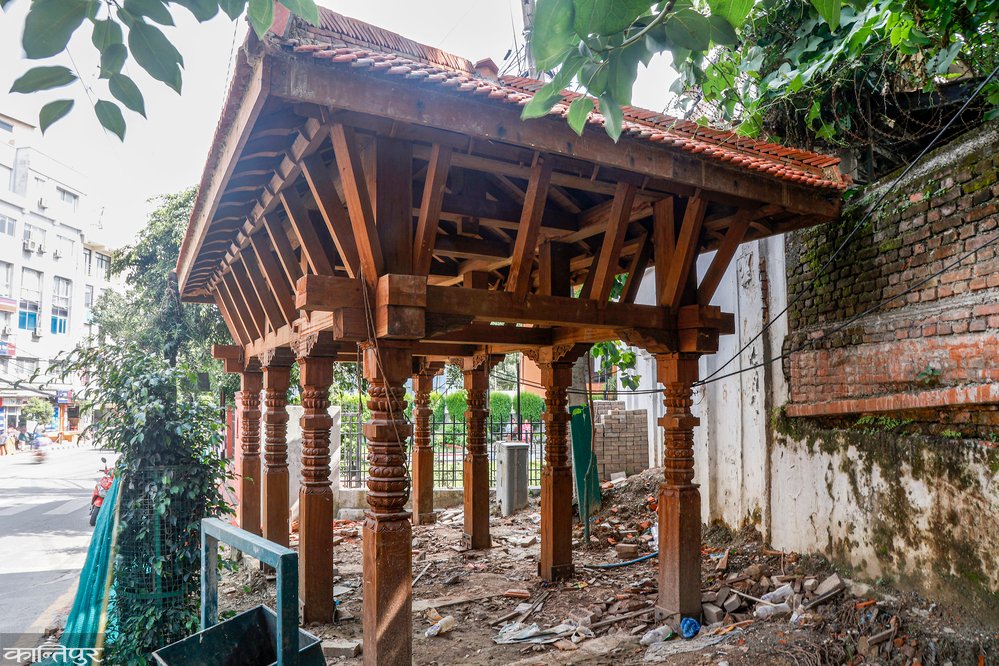Kathmandu, the heart of Nepal, is not only known for its bustling streets and ancient temples but also for its rich architectural and cultural traditions. In a modern initiative rooted in age-old customs, Kathmandu Metropolitan City (KMC) is constructing 25 traditional falchas wooden public rest shelters to offer a comforting pause for commuters while preserving the capital’s heritage.
These structures, deeply rooted in Nepal’s social and religious history, are more than just benches with roofs—they are community symbols where people once gathered to chat, share stories, rest, or seek shelter from the rain and sun. Now, these falchas are making a comeback—with a modern twist.
What Are Falchas? A Glimpse into Nepal’s Traditional Architecture
Falchas are traditional resting pavilions or wooden shelters, usually constructed with brick and timber, and designed to provide comfort to travelers and pedestrians. Historically, they were placed along busy travel routes or near temples and markets, often built by wealthy donors or religious groups as acts of merit.

falchas
In earlier times, falchas served as vital community hubs, especially for elderly citizens, spiritual gatherings, and resting travelers. They represent a part of Newar architecture and communal living that has slowly faded over the years due to urbanization.
Why Is Kathmandu Rebuilding Falchas Now?
The Kathmandu Metropolitan City recognized the need to balance modern infrastructure with cultural preservation. With increasing urban congestion and limited resting spaces, the city administration has come up with an innovative approach: reviving old traditions to serve today’s needs.
Here’s what the project aims to achieve:
Preserve Kathmandu’s cultural identity
Provide rest areas for daily commuters, including the elderly and people with disabilities
Reintroduce traditional architecture into the urban landscape
Encourage social interaction in public spaces
Offer shelter from Kathmandu’s harsh weather conditions
Where Are These Falchas Being Constructed?
The 25 falchas are being strategically placed across key city areas where foot traffic is high and commuter fatigue is common. These locations include:
Ratna Park
Kalanki
Baneshwor
Koteshwor
Other bustling parts of the city
Each falcha will be easily accessible to all—designed to include ramps for wheelchair access and seating suited for the elderly and people with mobility issues.
Traditional Techniques, Modern Implementation
While the intention is to preserve the traditional look and feel, the construction is technically modern and structurally safe. Here are a few highlights:
Built using Nepali wood and traditional joinery techniques
Roofed with tiles or traditional slate, echoing old Kathmandu
Designed with open walls, encouraging interaction and airflow
Average construction cost: Rs 30-35 lakh per falcha
By incorporating earthquake-resilient construction methods, the city ensures these falchas will stand the test of time—both culturally and physically.
What Do Locals Think?
Residents and commuters have welcomed the initiative with open arms. Many find the falchas a refreshing return to the Kathmandu of their childhood. For newer generations, they offer an opportunity to reconnect with heritage while enjoying practical benefits.
A daily commuter from Kalanki shared,
“It feels like the city cares again. We get a place to rest, and it reminds me of the stories my grandfather used to tell.”
Blending Urban Planning with Cultural Roots
This project is more than just building structures—it’s about reconnecting Kathmandu with its cultural identity. In a time where modern skyscrapers and concrete blocks dominate the skyline, introducing elements like falchas provides a harmonious blend of history and modernity.
Key benefits of this blend:
Promotes cultural tourism by showcasing traditional architecture in public spaces
Adds visual and aesthetic appeal to the city
Encourages community bonding
Supports local artisans and craftsmen involved in the construction
What Lies Ahead?
If the 25 falchas are successful and all signs suggest they will be KMC may expand the initiative across the entire Kathmandu Valley, even to neighboring districts.
This model of combining heritage revival with urban utility could inspire other Nepali cities (like Patan or Bhaktapur) to undertake similar projects.
The falchas of Kathmandu are not just shelters they’re symbols. Symbols of a city that refuses to forget its roots while moving forward. They offer locals and tourists alike a chance to pause, reflect, and reconnect with the essence of what Kathmandu once was—and what it still aspires to be.
If you’re planning to walk through the city soon, don’t be surprised to see one of these beautiful wooden structures along your route. Take a moment, sit down, breathe, and enjoy a piece of living heritage that’s the Kathmandu spirit.

